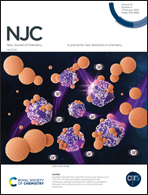Enhanced PMS/O2 activation by self-crosslinked amine-gluteraldehyde/chitosan-Cu biocomposites for efficient degradation of HEPES as biological pollutants and selective allylic oxidation of cyclohexene†
Abstract
Designing suitable methods to remove non-biodegradable and high-consumption compounds such as HEPES, whose removal from the environment has not been investigated so far, can lead to a useful and rapid readiness in facing the environmental threats caused by them. A magnetic-chitosan/amine-supported CuNP (MS-(AgC)/Cu) composite was fabricated through a facile co-precipitation method and illustrated to be an efficient biocomposite for activating peroxymonosulfate (PMS) or molecular oxygen for the degradation of HEPES as a biological pollutant for the first time and also for selective allylic oxidation of cyclohexene. The characterization of MS-(AgC)/Cu biocomposites by various analyses confirmed that an appropriate nature and particle size of the self-cross-linked amine–aldehyde–chitosan matrix could promote the dispersion of Cu NPs and consequently promote the catalytic performance of the activator. HEPES has been efficiently mineralized (TOC removal of ∼61.60) with PMS/MS-(AgC)/Cu with 98.3%, 69.5%, and 5.12% removal efficiency, a synergistic index, and reaction stoichiometric efficiency in wide pH ranges, respectively. The degradation process was found to show pseudo-first order kinetics with a low activation energy of 17.21 kJ mol−1. In the following, an understanding of its vital principles and relationship of removal efficiency with structural and environmental factors, economic study, long-term stability, recyclability, the degradation mechanism and universality of the system is assessed in detail. In addition, the MS-(AgC)/Cu biocomposite was found to have a good TOF (9.53 ± 0.06 h−1) with high catalytic activity, which is validated by excellent conversion and selectivity to 2-cyclohexene-1-one. Therefore, the new ecofriendly activator fabricated in this work with excellent performance could be a way forward for application in full- or large-scale water systems with heavy/trace amount of refractory compounds.



 Please wait while we load your content...
Please wait while we load your content...